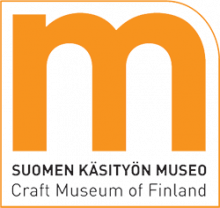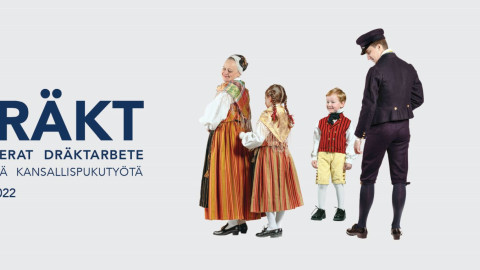FOLKDRÄKT – One hundred years of organised national costume work 23.9.2022–19.3.2023
This year marks the centenary of the start of systematic national costume work in the Finnish-Swedish Folk Culture Association Föreningen Brage. To mark the anniversary, Brage has put together an exhibition on the history of folk costume work. The exhibition will tour different museums between 2022 and 2023, and will be on display in the exhibition space of the National Costume Center of Finland at the Craft Museum of Finland in Jyväskylä from 23 September 2022 to 19 March 2023.
The exhibition will not only present beautiful national costumes, but also the story of how the costumes were born. There is a wealth of photographic material on display and a timeline tells the story of 100 years of systematic costume work. The national costumes on display in Jyväskylä come from Munsala, in Swedish-speaking Ostrobothnia. For the exhibition, Eija Mendelin has made new model costumes from Munsala dark women's costume and two men's costumes. Also on display is a metal-embroidered tykkimyssy cap, reconstructed by Maria Lindén.
Föreningen Brage
Föreningen Brage was founded in Helsinki in 1906 to preserve and nurture Finnish-Swedish folk culture, initially song and dance, later also costumes. The costume office in Brage was founded in 1907. Two years later, a costume committee (later the costume division) was established, which was tasked with researching and compiling national costumes.
In 1922, Brage sent an invitation to Finnish Swedish-speaking associations and regional organizations. At the costume congresses in 1922 and 1923, Brage and the representatives of the regions sketched guidelines for implementing the national costume idea: extensive field research, research of old documents and cataloging of fabric samples and clothing items. Systematic and thorough costume work had begun in earnest.
Together with the local committees, a woman's and a man's costume were prepared for each Swedish and bilingual municipality. Model costumes were made and costume booklets with descriptions were prepared. The costume office played an important role as a supervisor and as a broker and manufacturer of various costume materials and costume parts. Advice on costume matters was much needed, and in 1987 a national costume consultant was hired.
During the research trips, a large number of fabric samples and pieces of folk clothing from the period 1750–1850 were collected. They are the basis of the costume museum in Brage, together with model costumes. Since 1991, the costume office has exhibited selected ensembles from the collection. Brage manages an important tangible and intangible cultural heritage.
One hundred years of national costume culture
Through determination and cooperation, a distinctive costume culture has been created. In the changing world of the late 19th century, the image of peasant life as restful and unchanging fitted in with the national romantic vision of the upper classes. The traditional, colourful costumes of the peasantry came to be seen as a national cultural heritage.
To preserve the use of folk costumes for posterity, bourgeoisie, students and artists began to collect folk costumes from the 1700s and 1800s. When Emperor Alexander III visited Lappeenranta on 5 August 1885, a rowboat was donated to Empress Maria Fyodorovna. It was rowed by nine rowers wearing folk costumes. The costumes were made by the Friends of Finnish Handicraft, which was the model for the costume activities of the Finnish-Swedish Folk Culture Association Brage in the 20th century.
Are the national costumes identical copies of their paragons? No, because national costumes are reproductions of a lost costume culture. As research into the use of folk costumes has progressed, national costumes have been modified to make them as historically accurate as possible. The national costume is a living cultural heritage, although each generation leaves its mark on it.
Brage assembled the national costumes in close collaboration with local operators. Brage took the initiative, organised and led the work. Without the support and input of local people, the work would have been one-sided. It was mainly during Yngvar Heikel's expeditions, that discussions with the local population took place, who enthusiastically participated in the research work by giving interviews, answering questionnaires or supplying Brage with items of clothing. Local costume committees were set up and their members participated in the ethnographic fieldwork. Once the costume work had gathered momentum, there was no stopping the local population.
A vibrant and active rural community was an important prerequisite for the collection of national costumes. Teachers and youth clubs, among others, were at the forefront of the costume work, and community colleges also played an important role. The production of costumes also gave a new impetus to home crafts. Brage sought to ensure that the costume makers were local craftspeople from the countryside who had mastered the old techniques. The national costume work was characterised by a strong sense of collaboration, but it was not without its difficulties. While Brage was mainly concerned with the historical authenticity of the costumes, it may have been more important for local people to create a unique costume. This led to compromises on both sides.
Exhibition team
Maria Lindén, Henrietta Lindgren, Eija Mendelin, Kaja Grönlund and Gunilla Vuori
FOLKDRÄKT – One hundred years of organised national costume work at Brage
Exhibition at the Craft Museum of Finland Alley Gallery 23.9.2022-19.3.2023
Museum is open Tue-Sun 11-18. Holidays may effect opening times.

